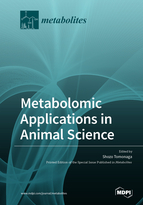Metabolomic Applications in Animal Science
A special issue of Metabolites (ISSN 2218-1989). This special issue belongs to the section "Animal Metabolism".
Deadline for manuscript submissions: closed (31 May 2020) | Viewed by 56519
Special Issue Editor
Interests: amino acids; imidazole dipepitdes; GC-MS based metabolomics; metabolomics in animal science; nutritional science for stress response; early nutrition
Special Issues, Collections and Topics in MDPI journals
Special Issue Information
Dear Colleagues,
Metabolomics has been a useful method for various study fields. However, its application in animal science seems not enough. Metabolomics will be useful for various studies in animal science: Animal genetics and breeding, animal physiology, animal nutrition, animal products (milk, meat, eggs, and their by-products) and their processing, livestock environment, animal biotechnology, animal behavior, and animal welfare. More application examples and protocols for animal science will promote more motivation to use metabolomics effectively in the study field.
Therefore, in this Special Issue, I invite research and review articles for “Metabolomic Applications in Animal Science”. The contribution to animal science should be clearly stated in the manuscript. The main methods used should be mass spectrometry, nuclear magnetic resonance spectroscopy, or other suitable techniques. Not only nontargeted but also targeted analysis of metabolites are welcome. The topics include dietary and pharmacological interventions, metabolic flux analysis, genetic manipulations, in vitro/in vivo imaging, and protocols for metabolomic experiments.
The Special Issue is open for submission now. Some extension may be granted if you kindly let me know in advance. Accepted papers will be published rapidly and will be listed together on the Special Issue website.
Dr. Shozo Tomonaga
Guest Editor
Manuscript Submission Information
Manuscripts should be submitted online at www.mdpi.com by registering and logging in to this website. Once you are registered, click here to go to the submission form. Manuscripts can be submitted until the deadline. All submissions that pass pre-check are peer-reviewed. Accepted papers will be published continuously in the journal (as soon as accepted) and will be listed together on the special issue website. Research articles, review articles as well as short communications are invited. For planned papers, a title and short abstract (about 100 words) can be sent to the Editorial Office for announcement on this website.
Submitted manuscripts should not have been published previously, nor be under consideration for publication elsewhere (except conference proceedings papers). All manuscripts are thoroughly refereed through a single-blind peer-review process. A guide for authors and other relevant information for submission of manuscripts is available on the Instructions for Authors page. Metabolites is an international peer-reviewed open access monthly journal published by MDPI.
Please visit the Instructions for Authors page before submitting a manuscript. The Article Processing Charge (APC) for publication in this open access journal is 2700 CHF (Swiss Francs). Submitted papers should be well formatted and use good English. Authors may use MDPI's English editing service prior to publication or during author revisions.
Keywords
- Animal science
- Livestock
- Metabolomics







